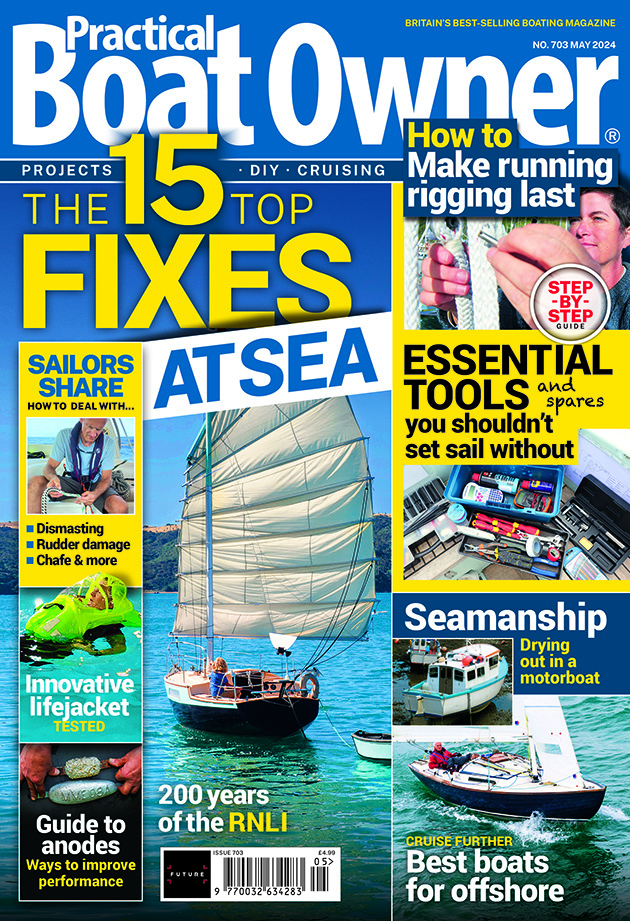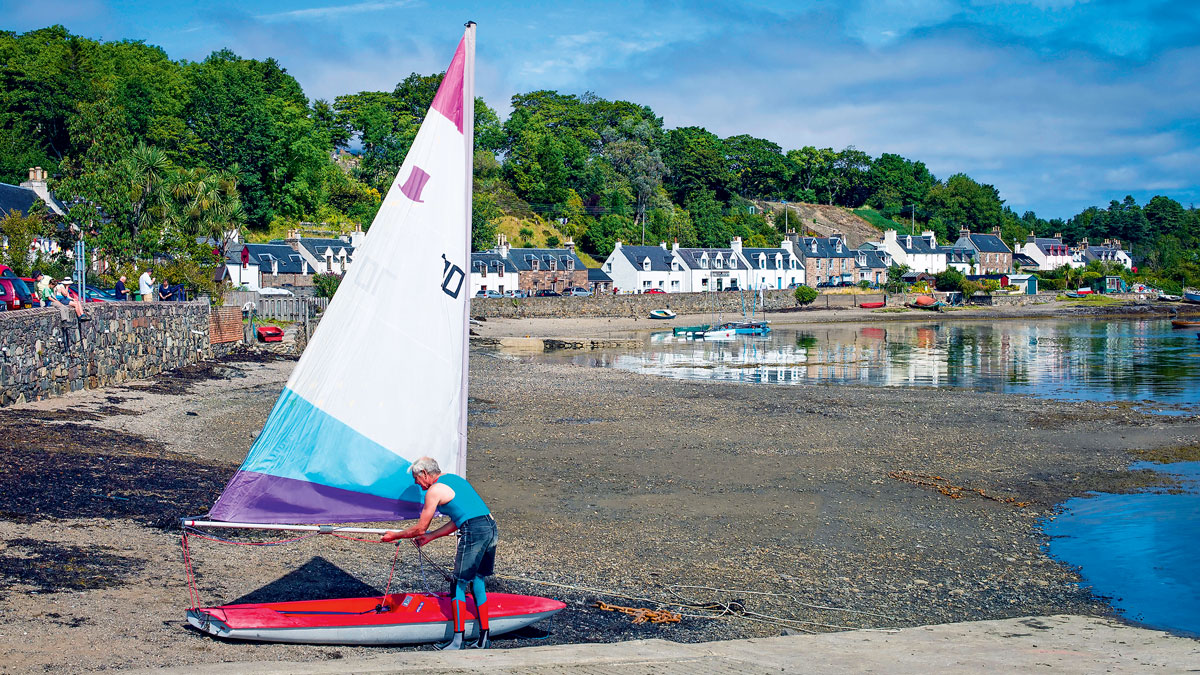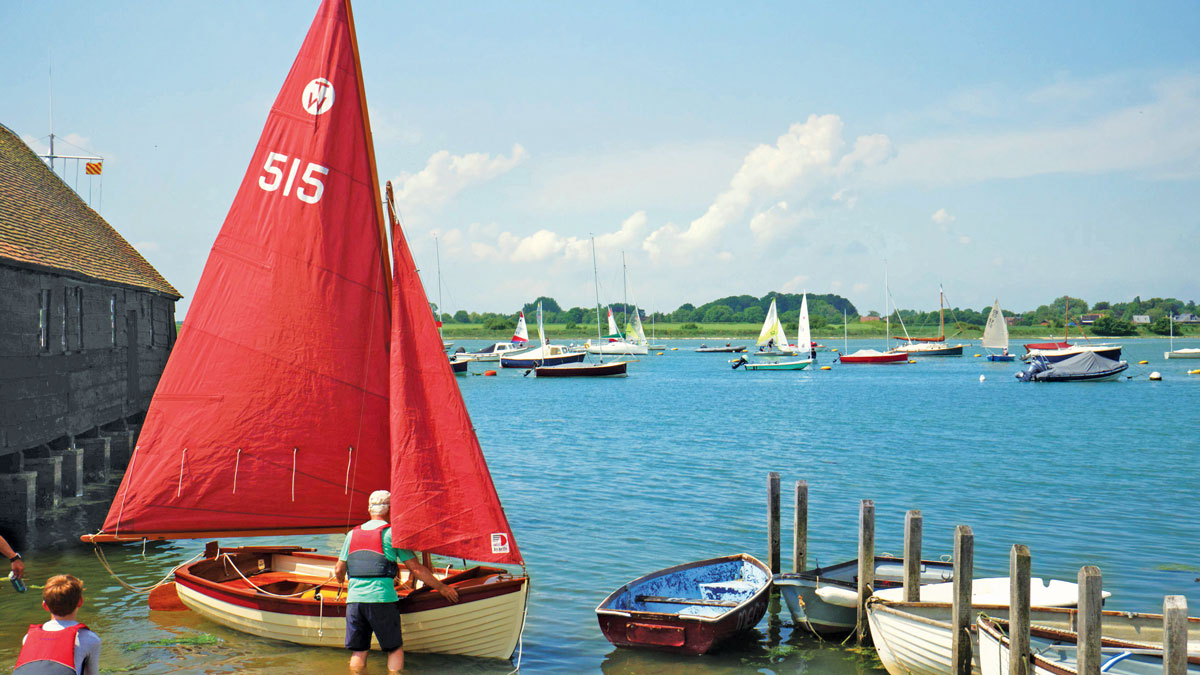Clive shares his love of the South Coast variety Avon Scow: 11ft lug-sailed boats with a heavy galvanised steel centreplate
Three things often said to be unnecessary in a small boat are an umbrella, a wheelbarrow and a naval officer.
The latter may be a tad unfair but my chum at the sailing club, a retired captain in the Royal Navy, would be the first to admit he struggled with little boats.
To be fair his responsibilities in the Navy had little direct involvement with boats.
He seemed to be able to put up with leaking centreboard cases and as time passed, in my quest to try out all boats, I ended up owning his leaky boats.

2024 marks 100 years since the first Yarmouth Scow was built. Credit: Roger Allen Photography/Alamy
One of these was a delightful Avon Scow.
I am talking about the South Coast variety, little 11ft lug sail boats with a heavy galvanised steel centreplate.
Scow boats come in a variety of styles such as the Avon, Keyhaven, Lymington, West Wight, Bembridge and Chichester Scow.
There are others, originally constructed of clenched wood, most are now GRP with a hardwood fit out.
They are sturdy little sea boats designed mainly for club use and cope well with the Solent chop.
Most have a steel centreplate which adds weight and aids stability. The distinctive cutaway forefoot makes scows easy to tack and their broad transom adds to their inherent stability.
Continues below…
Sailing surfboats: Lasers, the Lightning 368 and more!
Clive Marsh looks at sailing surfboats - the Seabat, Minisprint, Lightning 368 and more!
Tideway 12: seaworthy and stable
Prolific boat owner Clive Marsh extols the virtues of the Tideway 12, which can be launched by hand from a
What is a lugger? And why they make great trailer-sailers – answered!
Compulsive boat owner Clive Marsh explains why little luggers make perfect trailer-sailers
Lune Pilot 11: why you should sail this fine, little boat
A very interesting boat with a long keel, which makes it slightly unusual for a dinghy
The modern hulls of an Avon Scow are formed in GRP and are approximately 11ft 3in (3.40m) long with a 4ft 6in (1.37m) beam.
The mast, boom and yard may be constructed of either wood or tubular alloy. The mast is supported by two shrouds and a forestay.
The balanced lug sail is approximately 63ft2 (5.85m2) with no battens, but sail area varies by class.
Modern scow boats tend to have buoyancy tanks although some still use buoyancy bags which have certain advantages when it comes to maintenance and repairs of the hull.
Scow boats vary in weight. Mine was approximately 265lb (120.5kg) which is more than twice the weight of a 98lb (45.5kg) Mirror Dinghy so if you want to protect your back a scow might not be ideal.

Clive’s blue scow with well- fitting grandson. Credit: Clive Marsh
The combined weight of the boat and trolley makes hauling up a steep slipway a challenge for some. I use a car or zigzag up the slip using chocks.
Usually when people see me struggling they come and help. I have always used my scows for day sailing and visiting pubs and beaches.
Scow boats are nice stable craft ideal for taking out a young grandchild or two.
Mine are now far too big for comfort. If you want to race then each scow class is raced keenly and you can find details of events by joining the group for your type of scow.
Some sailing clubs have large scow fleets that race regularly.
My first launch was from the slipway near the Master Builders Hotel by Buckler’s Hard on the Beaulieu River.
The plan was to stay at the hotel and set out for day sails after a comfortable night’s sleep and a good breakfast.

A scow sailing in Chichester Harbour
The harbourmaster had found me a little mooring on the inside of a pontoon where the yachts avoided.
All in all a perfect set up with a mooring, a good hotel and the West Solent at hand.
The first morning we took the flood tide upriver to visit the village of Beaulieu and have morning coffee somewhere before returning down river at slack tide and head out into the Solent for a good open water sail.
We had oars in case of need but no engine. The little boat sailed very well in the perfectly steady Force 2, tacked, gybed and generally did whatever was asked of her in the narrow river.
There was only one problem. You might notice that scow sailors often sit on the cockpit sole rather than the thwart.
This we did but of course had forgotten about the boat’s leaky centreboard case. Our RN Captain seemed happy sitting in a puddle.

Clive’s Avon Scow moored at Buckler’s Hard. Credit: Clive March
Consequently, my wife Brenda and I both ended up with wet undercarriages which made us feel and look a little uncomfortable when walking through the village looking for a coffee shop.
The problem was easily fixed with a new soft washer at the point on the case where the centreboard pin is bolted.
This is a common problem and when fixing do not overtighten, or you’ll distort the centre case.
We returned to the hotel where Brenda spent the afternoon reading on the riverbank while I sailed downriver for a sail.
Later, there was enough wind to sail back into the river against the remainder of the ebb and tie up to my mooring just in time for a shower and dinner at the hotel.
My next Avon Scow break was at Chichester Harbour where we stayed at the Mill Stream Hotel in Bosham.
This is a very comfortable hotel which at that time had a French chef. They looked after us and were happy for me to keep the dinghy in their car park.
I walked the dinghy down the road to the hard or, if the tide was out, to the slipway to launch.
Walking the boat back up the hill was certainly good exercise necessitating a halfway stop at the tea shop on the corner.
A Mirror dinghy would have been a lot easier. The Scow is an ideal Chichester boat for a day sail over to East Head where you can beach and take a break.
In recent times Flight Marine have designed and built their own Chichester Scow.
These attractive Scows are a tad lighter than most at 220lb (100kg) and with a jockey wheel on their launching trolley are very manageable.
Another Chichester place I like to stay at is the Ship Inn at Itchenor just opposite the hard and close to the Harbourmaster’s office – which makes paying the harbour dues easy.
I usually buy an annual ticket which is very reasonable for a small dinghy.
I sailed my Avon Scow mainly out of Rye and kept her for a few years until I decided that I might as well get a bigger dinghy for a similar weight to the scow.
But after a while, I missed her so bought another, this time blue hulled.
This one had no built-in buoyancy, just bags and I changed her for an orange one with very adequate buoyancy tanks.
I have never felt close to a capsize in any of my three Avon Scows but boating near Hurst Castle I noticed a mature sailor capsize and struggle to get the boat up.
He must have been very unlucky and perhaps was caught in a squall.
A club rescue boat came to his aid. I’m currently without a scow but if I see a nice one I might just buy a fourth.
Enjoy reading Scow boats: sturdy little sea-going vessels?

A subscription to Practical Boat Owner magazine costs around 40% less than the cover price.
Print and digital editions are available through Magazines Direct – where you can also find the latest deals.
PBO is packed with information to help you get the most from boat ownership – whether sail or power.
-
-
-
- Take your DIY skills to the next level with trusted advice on boat maintenance and repairs
- Impartial in-depth gear reviews
- Practical cruising tips for making the most of your time afloat
-
-
Follow us on Facebook, Instagram, TikTok and Twitter








